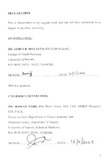| dc.description.abstract | Background
Soft tissues sarcomas are the most frequent sarcomas. They represent a rare group of
solid mesenchymal tumours with high rates of morbidity and mortality that are influenced
by patient, tumour, and treatment factors .. Large series report recurrence rates of between
20-25 %, usually within 2-3 years after surgical treatment. In Africa, many of the patients
present late, and have to travel long distances to treatment centres. Access to adjuvant
therapy is not guaranteed either. Consequently, the patterns and rates of recurrences may
differ from quoted literature.
Purpose/aim of study
To determine the pattern and factors associated with recurrence III patients treated
surgically for soft tissue sarcomas at the Kenyatta National Hospital.
Study design
A five and a half years retrospective study between January 2003 and June 2007 and a six
months prospective follow-up arm between July 2008 and March 2009.
Patient and methods
Retrospectively, as well as prospectively collected data from a population of patients
selected from all those surgically treated at the Kenyatta National Hospital, between
January 2003 and March 2009, for soft tissue sarcomas were reviewed. Primary data
included demographic variables (age and sex), clinical variables (duration of symptoms,
anatomical distribution, radiological tests undertaken, adjuvant therapy given) and
pathological variables (tumour type, size, grade stage and surgical margins status). The
outcome variables were tumour recurrence and death.
The variables that were studied to determine a relationship with recurrence were:
patient age, tumour site, grade, histological type, microscopic involvement of surgical
margins by tumour and whether or not adjuvant chemotherapy and / or radiotherapy were
instituted.
Data Analysis
Univariate analyses were used to determine the influence of each variable on the
outcome. P<0.05 was considered significant.
Results
Mean age was 32.52±18.17 years. The age group distribution was bimodal with peaks at
10-19 years and 40-49 years. The male/ female sex ratio was 0.97:1. The mean duration
of symptoms was 110.87±18.75 months. The extremities had the most number of cases
(62%). Fibrosarcoma was the most common histological type (36.0%) and the mean
tumour size was 13.0 ±7.36 em. Most (44.7%) patients presented with high grade
tumours and 78.0 % of the patients presented with a recurrence. Most of the recurrences ..
(71.7%) occurred within the first year of treatment.
Failure to get adjuvant therapy (p<0.001), tumour size >5cm (p=0.02), advanced stage
(III and IV) (p<0.001), and positive microscopic margins (p<0.001) were adverse
prognostic factors for getting a recurrence. Presentation with a recurrent tumour
(p<0.027), failure to receive adjuvant therapy (p<0.001), advanced stages (III and IV)
(p<0.001), positive microscopic margins (p<0.001), and high grade tumours (p<0.001),
were all adverse prognostic factors for death. Patients who underwent wide, radical
excisions or amputations were less likely to die than those who underwent intra-lesional
or marginal excisions (p=0.05). For patients who received adjuvant therapy,
chemotherapy, compared to radiotherapy, was an adverse factor for death (p=0.003).
Intralesional and marginal excisions, versus amputations/wide or radical excisions
(p=0.05) and distant recurrence in the lungs/chest were also adverse factors for death
(p=0.001).
Conclusions
Advanced stages of soft tissue sarcomas, higher histological grades, positive microscopic
surgical margins, and failure to receive adjuvant treatment influenced both recurrence and
mortality after surgical treatment. In addition a tumour> 5cm was a negative prognostic
factor for recurrence, while presentation with a primary recurrent tumour and
intralesional or marginal tumour excisions were negative prognostic factors for death.
Better outcome results from surgical treatment of soft tissue sarcomas may be achieved if
efforts to treat them earlier were to be a reality. | en |
| dc.description.department | a
Department of Psychiatry, University of Nairobi, ; bDepartment of Mental Health, School of Medicine,
Moi University, Eldoret, Kenya | |

